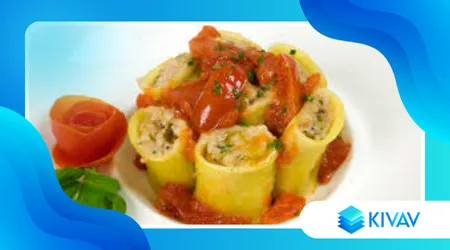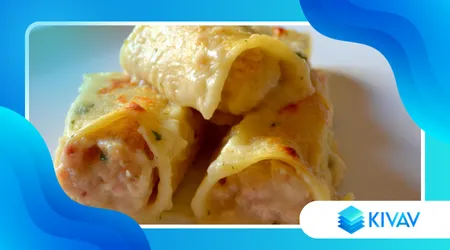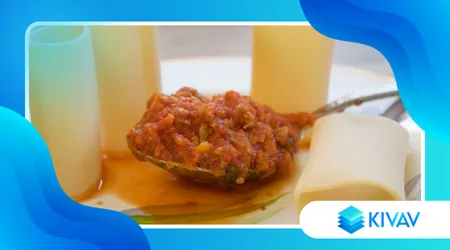Paccheri stuffed with Neapolitan ragù: a Neapolitan Sunday dish.

The majestic dish of the Paccheri stuffed with Neapolitan ragù It's not just a recipe. It represents the quintessential Neapolitan Sunday.
Announcements
This dish is a celebration of slow cooking, deep flavor, and family conviviality. It's the result of hours of loving cooking, a ritual passed down from generation to generation.
Let's now delve into the historical and cultural reasons that make this dish a true icon. It's an experience that goes far beyond simple nutrition.
What Makes Neapolitan Ragù a Symbol of Celebration and Family?
Neapolitan ragù is clearly different from other regional meat and tomato dishes. It's not a simple sauce, but a complex symphony of flavors.
Its preparation requires almost monastic patience, a commitment that begins at dawn. The meat, from various cuts, must be "pippiare," or slowly simmered.
Announcements
This slow and constant process guarantees an unparalleled tenderness and blend of flavors.
Various types of meat are used: beef muscle, pork ribs, and sometimes even stuffed chops. The secret lies in cooking it for hours.
Tradition dictates that the ragù is prepared on Saturday. Thus, on Sunday morning it's ready to welcome the pasta.
Which Paccheri Should You Use: Smooth or Ridged, and Why Is the Filling Important?
The choice of pasta shape is no accident in this context. Paccheri, large and cylindrical, are ideal for holding the filling.
But why fillings? The filling elevates the dish from a simple "first course" to a "main course."
This filling is often made with ground meat, eggs, cheese, and sometimes pieces of ragù. Their ring-like shape is perfect. They provide a solid base that holds the flavor.
There's some debate about whether to use smooth or ridged paccheri. The ridged ones adhere better to the sauce.
The smooth ones, on the other hand, enhance the silkiness of the pasta. Either way, the result is always an explosion of flavor.
Paccheri stuffed with Neapolitan ragù: What is the historical origin of this delicacy?
The history of ragù in Naples has ancient roots. Its origins are often traced back to French culinary influences.
The term “ragù” derives from “ragoût” (from the French ragout, which means “to awaken the appetite”).
This preparation was adapted from aristocratic cuisine. It later spread to the common people. The need to flavor less expensive meats gave rise to this technique.
Learn more: Pasta and beans, Neapolitan style: the humble dish that conquered Italy
With the addition of tomatoes, which came from the Americas, the ragù was transformed.
It became the recipe we know today. It's a living testament to Neapolitan gastronomic evolution.

How do you prepare authentic paccheri stuffed with Neapolitan ragù?
The preparation of these Paccheri stuffed with Neapolitan ragù It's an act of love. It requires attention and the selection of high-quality ingredients.
The ragù begins with a sauté of onion in extra virgin olive oil. The pieces of meat are then sealed for a more intense flavor.
Interesting: Tagliolini with Truffles: An Elegant Recipe
Then add the tomato puree and fresh basil. Slow cooking, called "pippiare," is crucial. It must last at least six hours, over very low heat.
The filling is made by combining ground beef, ricotta, smoked provola, and Parmesan. The paccheri, cooked al dente, are carefully stuffed.
They're then placed in a baking dish with a little ragù and mozzarella. Finally, they're baked for a final crispy golden brown.
Socio-Cultural Relevance Analysis and Historical References
This dish isn't just gastronomically significant. It has profound socio-cultural significance.
It's the central element of Sunday family gatherings. It symbolizes abundance and well-being.
Real Data: According to the Naples Chamber of Commerce, in 2024, the pasta and traditional baked goods sector recorded a 5% growth in exports, with traditional shapes such as paccheri among the most popular.
++ Ferrarese Tenerina Cake: Pure Chocolate with a Dark Chocolate Heart
This underlines the global interest in these specialties.
This recipe is truly an intangible heritage. An apt analogy would be to compare Neapolitan ragù to a symphony orchestra.
Each ingredient (the tool) plays a unique role. But only the direction (the cooking) produces the final harmony.
The Key Word in the Kitchen: The Triumph of Paccheri Stuffed with Neapolitan Ragù
The quest for culinary authenticity is ever-increasing. The trend for authentic "comfort food" is growing.
That's why the Paccheri stuffed with Neapolitan ragù They're experiencing a newfound popularity. They're a refuge from fast food.
This dish embodies the most authentic gastronomic tradition. An original example: during the pandemic, many families rediscovered slow food.
Making ragù became a therapeutic activity. It provided a sense of normalcy and connection.
Another statistic: 40% of tourists visiting Naples cite food as the main reason for their trip. This data highlights the importance of local food.
The Science Behind the Flavor: The Secrets of Paccheri Stuffed with Neapolitan Ragù
The magic of flavor lies in the Maillard reaction. This process occurs during the browning of meat. The caramelization of sugars and amino acids creates complex flavors.
Long, low-temperature cooking is essential. This allows the meat's collagen to transform into gelatin.
This gelatin makes the sauce thick and velvety. The acidity of the tomato balances the fattiness of the meat.

Let's look at the different cuts of meat used in ragù.
| Cut of Meat | Role in the Ragù | Characteristics |
| Beef Muscle | Flavor base, structure | Lean meat, rich in collagen |
| Rack of pork ribs | Fatness, sweetness | Fatty meat, gives consistency |
| Tracchiolelle | Intensity of taste | Bone that releases marrow and flavor |
This combination isn't a coincidence. It's the result of centuries of experience. Isn't this the secret ingredient in every great dish?
The Legacy of Paccheri Stuffed with Neapolitan Ragù
THE Paccheri stuffed with Neapolitan ragù They're more than a meal. They're a cultural legacy, a link to the past. They represent the joy of gathering around the table.
The effort put into preparing it is rewarded by the expressions on the diners' faces. It's a celebration of life on a plate. This true masterpiece deserves to be honored.
Frequently Asked Questions
Can I prepare the ragù in advance?
Absolutely. In fact, Neapolitan tradition dictates that ragù be prepared on Saturday. The next day, the flavors are even more intense and harmonious.
What's the difference between Ragù and Bolognese sauce?
Neapolitan ragù is made with whole pieces of meat and larger cuts, cooked for hours. Bolognese sauce uses minced meat and is generally cooked for a shorter time, often with the addition of milk or cream.
Which wine pairs best with Paccheri stuffed with Neapolitan ragù?
We recommend a structured and full-bodied red wine from Campania. An Aglianico or Taurasi are excellent choices. Their acidity and tannins balance the richness of the ragù.
Can you freeze ready-made stuffed paccheri?
Yes, the Paccheri stuffed with Neapolitan ragù They can be frozen after assembly but before baking. To thaw, transfer them to the refrigerator and then bake them as usual.
What is the most traditional cheese for filling?
The traditional cheese used is sheep's ricotta, mixed with grated Parmesan or pecorino to enhance the flavor. Smoked provola is sometimes added.
Is it essential to use paccheri or can I use another format?
Although paccheri are the traditional format for the Paccheri stuffed with Neapolitan ragù, it is possible to use other large formats suitable for the filling.
For example, cannelloni or Gragnano pasta. However, paccheri offer the best presentation.
How long does it take to get the perfect “pippiare”?
The ideal "pippiare" requires 5 to 8 hours of cooking on a very low heat. The flame must be so low that to snort (mumble) the sauce just enough. This ensures maximum tenderness.
